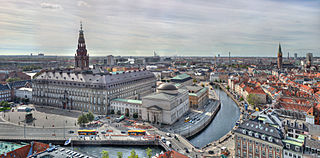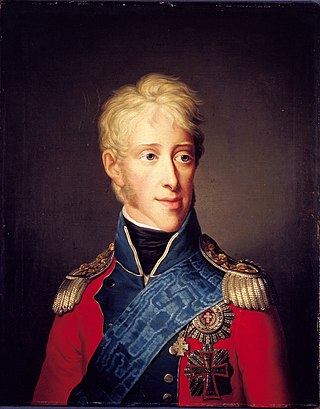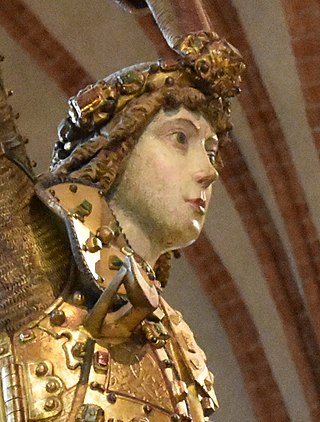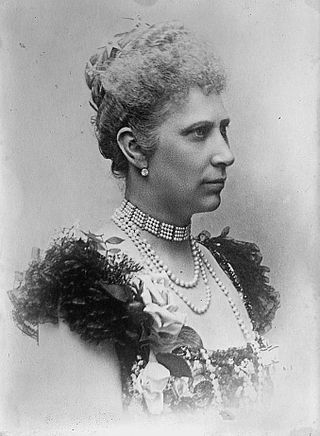
Copenhagen is the capital and most populous city of Denmark, with a population of around 1.4 million in the urban area, and more than 2 million in the wider Copenhagen metropolitan area. The city is on the islands of Zealand and Amager, separated from Malmö, Sweden, by the Øresund strait. The Øresund Bridge connects the two cities by rail and road.

The Kalmar Union was a personal union in Scandinavia, agreed at Kalmar in Sweden, that from 1397 to 1523 joined under a single monarch the three kingdoms of Denmark, Sweden, and Norway, together with Norway's overseas colonies.

Margrethe II is Queen of Denmark. Having reigned as Denmark's monarch for over 50 years, she is Europe's longest-serving current head of state. As of 2023, she is also the world's only queen regnant.

Christian X was King of Denmark from 1912 to his death in 1947, and the only King of Iceland as Kristján X, in the form of a personal union rather than a real union between 1918 and 1944.

Christian IX was King of Denmark from 1863 until his death in 1906. From 1863 to 1864, he was concurrently Duke of Schleswig, Holstein and Lauenburg.

Christian VII was a monarch of the House of Oldenburg who was King of Denmark–Norway and Duke of Schleswig and Holstein from 1766 until his death in 1808. For his motto he chose: "Gloria ex amore patriae".

Frederick IX was King of Denmark from 1947 to 1972. Born into the House of Glücksburg, Frederick was the elder son of King Christian X and Queen Alexandrine of Denmark. He became crown prince when his father succeeded as king in 1912. As a young man, he was educated at the Royal Danish Naval Academy. In 1935, he was married to Princess Ingrid of Sweden and they had three daughters, Margrethe, Benedikte and Anne-Marie. During Nazi Germany's occupation of Denmark, Frederick acted as regent on behalf of his father from 1942 until 1943. Frederick became king on his father's death in early 1947. During Frederick IX's reign Danish society changed rapidly, the welfare state was expanded and, as a consequence of the booming economy of the 1960s, women entered the labour market. The modernization brought new demands on the monarchy and Frederick's role as a constitutional monarch. Frederick IX died in 1972, and was succeeded by his eldest daughter, Queen Margrethe II.

Anne-Marie is a Greek and Danish royal who was the last queen of Greece as the consort of King Constantine II from their marriage on 19 September 1964 until the abolition of the Greek monarchy on 1 June 1973.

Christian I was a Scandinavian monarch under the Kalmar Union. He was king of Denmark (1448–1481), Norway (1450–1481) and Sweden (1457–1464). From 1460 to 1481, he was also duke of Schleswig and count of Holstein. He was the first king of the House of Oldenburg.

Frederick I was King of Denmark and Norway. He was the last Roman Catholic monarch to reign over Denmark and Norway, when subsequent monarchs embraced Lutheranism after the Protestant Reformation. As king of Norway, Frederick is most remarkable in never having visited the country and was never crowned as such. Therefore, he was styled King of Denmark, the Vends and the Goths, elected King of Norway. Frederick's reign began the enduring tradition of calling kings of Denmark alternatively by the names Christian and Frederick, which has continued up to the reign of the current monarch, Margrethe II.

Frederick VI was King of Denmark from 13 March 1808 to 3 December 1839 and King of Norway from 13 March 1808 to 7 February 1814, making him the last king of Denmark–Norway. From 1784 until his accession, he served as regent during his father's mental illness and was referred to as the "Crown Prince Regent". For his motto he chose God and the just cause and since the time of his reign, succeeding Danish monarchs have also chosen mottos in the Danish language rather than the formerly customary Latin. As Frederick VI had no surviving sons to succeed him, he was succeeded on the throne of Denmark by his half-first cousin Christian, who was his father's half-brother's son.

Sten Sture the Elder was a Swedish statesman and regent of Sweden from 1470–1497 and 1501–1503. As the leader of the victorious Swedish separatist forces against the royal unionist forces during the Battle of Brunkeberg in 1471, he weakened the Kalmar Union considerably and became the effective ruler of Sweden as Lord Regent for most of his remaining life.

Frederick IV was King of Denmark and Norway from 1699 until his death. Frederick was the son of Christian V of Denmark-Norway and his wife Charlotte Amalie of Hesse-Kassel.

Dorothea of Brandenburg was a Hohenzollern princess who became a Scandinavian queen by marriage under the Kalmar Union. She was Queen of Denmark, Norway, and Sweden from her marriage to King Christopher III in 1445 until Christopher died in 1448. As the wife of King Christian I, Dorothea was Queen of Denmark from their marriage in 1449 and Queen of Norway from 1450 until Christian's death in 1481. She was also Queen of Sweden during Christian's reign in that kingdom from 1457 to 1464. She served as interim regent during the interregnum in 1448, and as regent in the absence of her second spouse during his reign. She was the mother of two future kings of Denmark: John and Frederick I.

Louise of Sweden was Queen of Denmark from 1906 until 1912 as the spouse of King Frederick VIII.

Caroline Matilda of Great Britain was Queen of Denmark and Norway from 1766 to 1772 by marriage to King Christian VII.
Count Christian of Rosenborg was a member of the Danish royal family. Born Prince Christian of Denmark, he was high in the line of succession until the constitution was changed in 1953 to allow females to inherit the crown, placing his branch of the dynasty behind that of his cousin Margrethe and her two younger sisters. He later gave up his princely rank and his rights to the throne in order to marry a commoner.

The monarchy of Denmark is a constitutional institution and a historic office of the Kingdom of Denmark. The Kingdom includes Denmark proper and the autonomous territories of the Faroe Islands and Greenland. The Kingdom of Denmark was already consolidated in the 8th century, whose rulers are consistently referred to in Frankish sources as "kings". Under the rule of King Gudfred in 804 the Kingdom may have included all the major provinces of medieval Denmark.
Events from the year 1874 in Denmark.
Events from the year 1731 in Denmark.

















